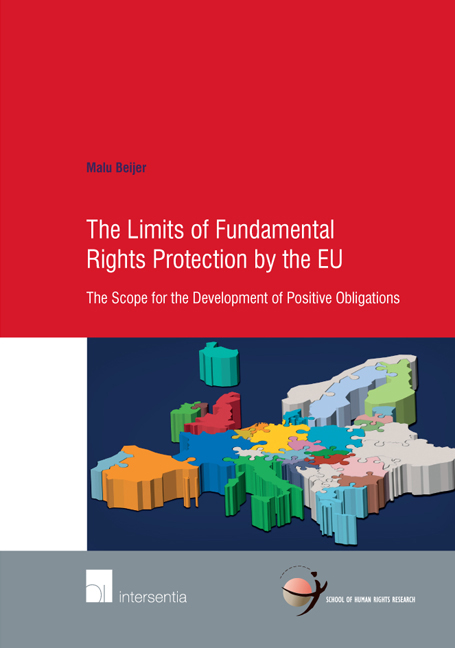 Limits of Fundamental Rights Protection by the EU
Limits of Fundamental Rights Protection by the EU Book contents
- Frontmatter
- About the Author
- Acknowledgements
- Contents
- Abbreviations
- Table of Cases
- Chapter 1 Introduction
- PART I THE CONCEPT OF POSITIVE OBLIGATIONS WITHIN THE CONTEXT OF THE EUROPEAN CONVENTION ON HUMAN RIGHTS
- Chapter 2 The System of Fundamental Rights Protection Under the European Convention on Human Rights
- Chapter 3 The Development of Positive Obligations Under the European Convention on Human Rights
- Chapter 4 A Critical Appraisal of the Development of Positive Obligations Under the European Convention on Human Rights
- Chapter 5 Part I – Conclusions
- PART II THE SCOPE FOR THE DEVELOPMENT OF POSITIVE OBLIGATIONS WITHIN THE CONTEXT OF EU LAW – AN ANALYSIS OF THE SPECIFIC PARAMETERS OF THE EU LEGAL ORDER AND THE EU SYSTEM OF FUNDAMENTAL RIGHTS PROTECTION
- PART III SYNTHESIS
- Bibliography
- Index
- Miscellaneous Endmatter
Chapter 5 - Part I – Conclusions
from PART I - THE CONCEPT OF POSITIVE OBLIGATIONS WITHIN THE CONTEXT OF THE EUROPEAN CONVENTION ON HUMAN RIGHTS
Published online by Cambridge University Press: 27 September 2018
- Frontmatter
- About the Author
- Acknowledgements
- Contents
- Abbreviations
- Table of Cases
- Chapter 1 Introduction
- PART I THE CONCEPT OF POSITIVE OBLIGATIONS WITHIN THE CONTEXT OF THE EUROPEAN CONVENTION ON HUMAN RIGHTS
- Chapter 2 The System of Fundamental Rights Protection Under the European Convention on Human Rights
- Chapter 3 The Development of Positive Obligations Under the European Convention on Human Rights
- Chapter 4 A Critical Appraisal of the Development of Positive Obligations Under the European Convention on Human Rights
- Chapter 5 Part I – Conclusions
- PART II THE SCOPE FOR THE DEVELOPMENT OF POSITIVE OBLIGATIONS WITHIN THE CONTEXT OF EU LAW – AN ANALYSIS OF THE SPECIFIC PARAMETERS OF THE EU LEGAL ORDER AND THE EU SYSTEM OF FUNDAMENTAL RIGHTS PROTECTION
- PART III SYNTHESIS
- Bibliography
- Index
- Miscellaneous Endmatter
Summary
THE MAIN FEATURES RELATING TO THE DEVELOPMENT OF POSITIVE OBLIGATIONS BY THE ECtHR
This chapter aims to bring together the conclusions of part I of this study, regarding the concept of positive obligations within the context of the Convention. This chapter focuses on some of the topics that will be especially relevant for part II of this study, which examines whether a similar development of positive obligations can take place within the EU ‘ s system of fundamental rights protection. Keeping that objective in mind, it is especially important here to formulate some conclusions regarding the definition of the concept of positive obligations in combination with the distinction that applies between positive and negative obligations (section 5.2.), as well as regarding the different types of positive obligations that can be identified in the case-law of the ECtHR (section 5.3.). The rationales used by the ECtHR for accepting the different types of positive obligations together with the possible effects of positive obligations are explained (section 5.4.). The main points of criticism related to this development are discussed (section 5.5.) and, lastly, some final remarks are provided with respect to the analysis presented in part II (section 5.6.).
THE DEFINITION OF POSITIVE OBLIGATIONS AND THE DISTINCTION BETWEEN POSITIVE AND NEGATIVE OBLIGATIONS
The ECtHR broadly defines a positive obligation as a requirement for states to take active measures to protect fundamental rights. It also has been seen in the preceding chapters that the ECtHR oft en applies the term ‘ positive obligations ‘ in its judgments to indicate the obligations that states must fulfil to ensure the protection of a fundamental right within the relations between individual parties, and in its own relations with individuals. To some extent, it appears to be difficult to arrive at a more clear and helpful definition of the concept of positive obligations. The definition necessarily needs to be broad to cover the different types of positive obligations which are recognised by the ECtHR (see section 5.3.).
- Type
- Chapter
- Information
- Limits of Fundamental Rights Protection by the EUThe Scope for the Development of Positive Obligations, pp. 99 - 106Publisher: IntersentiaPrint publication year: 2017
